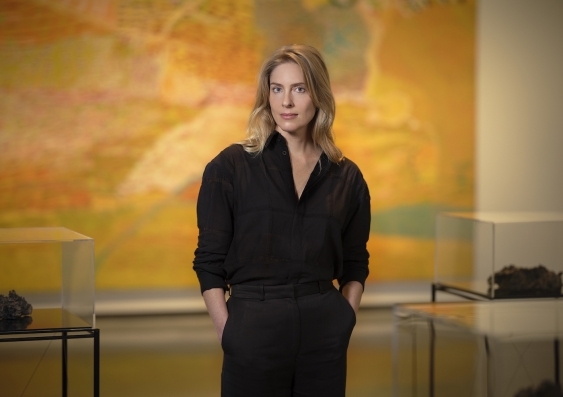The art of curation
There is more to curating an exhibition than meets the eye.
There is more to curating an exhibition than meets the eye.

When it comes to art exhibitions, it is quite easy to be swept up by the wonder of the incredible artworks on display. And while that is by design, that doesn’t mean exhibitions just come together all by themselves.
One person who knows just how much work goes into an art exhibition is Anneke Jaspers. The curatorial studies PhD candidate at the UNSW School of Art & Design has overseen dozens of contemporary art exhibitions throughout her decade-long career in public art institutions.
Ms Jaspers says that an exhibition can take months or even years of full-time planning, research, fieldwork, studio visits and behind the scenes administration work before installation even begins. But for contemporary curators like Ms Jaspers, it first and foremost involves working with living artists.
“My method is primarily grounded in dialogues with artists,” she says. “I’ve had a big focus on commissioning new work – guiding the research and development of projects with artists.”
In her current role as Senior Curator at the Museum of Contemporary Art, Ms Jaspers oversees the development and display of the Museum’s permanent holdings.
“Now that I’m focusing [more] on collections in my work, it’s quite different because you’re dealing with extant material, which means a completely different research method and process,” she says.
“When you work with collections, you often need to begin with the objects themselves and a kind of close encounter with their materiality, as well as researching the artists’ intentions at the time they were made.”
Ms Jaspers says for curators, the work doesn’t stop after an exhibition is unveiled to the public.
“People might think that your job is done when the exhibition opens. But in fact, that’s when you start to discover all these new things about the show,” she says.
“You go from doing all this mapping and development work in a very abstract fashion, with screens and with pinboards, and in sketch ups and models … to it becoming actualised in a space. All of this new information is revealed around how [things] interact with one another, which is so satisfying as a curator and part of your own kind of learning process.”
At its best, curation is a synthesis with artistic practice, she says.
“Contemporary curatorial practice works in symbiosis with artistic practice,” she says. “But there’s no way around an exhibition being inflected with your sort of personality and curatorial style.”
Curators have their own distinct styles, Ms Jaspers says. Some generate a sense of drama, dynamism, and extraversion, while others make shows more reflective and quieter in revealing underlying ideas. Ms Jaspers herself prefers subtlety, describing her style as more minimal.
“I like to give works their own space to speak on their own terms,” she says. “I also think a more spacious display often encourages audiences to give each work more attention and to bring a sense of curiosity to how the works have been sequenced and brought together. It encourages people to develop their own reading of the show.”
Her latest curatorial project, a major long-term exhibition of the Museum of Contemporary Arts’ collection, MCA Collection: Perspectives on place, brings together artworks that explore the social and physical aspects of place. It has been imagined as an expanded map, which weaves together a picture of the world made from rituals, memories, metaphors, imprints, and repurposed materials, and includes over 60 pieces across media, including painting, video, sculpture, and photography.
“The theme of the show is a very timely concept, and one that is particularly rich to explore in Australia, given the complexities and the contestation around how we inhabit this land,” Ms Jaspers says. “It was important to me that the exhibition would create a dialogue between Aboriginal and Torres Strait Islander practice and work by non-Indigenous artists.”
Ms Jaspers hopes the latest collection display will be a dynamic space for learning.
“There are lots of different ways you can engage with an exhibition like this. We’ve had many school groups coming through, which gives me a great amount of joy,” she says. “And as the COVID situation shifts, we will begin generating more public programmes and events that will give people different kinds of insights into the themes as well.”
Ms Jaspers says while art curating isn’t the most conventional career path, she wouldn’t have it any other way.
“It’s hard to imagine a clear trajectory in the arts; it’s quite different to other fields in that way. There’s a lot of different directions you can go in, but not very many clear pathways,” she says.
“I’ve found a place for myself in the field of exhibition-making and public institutions, which I love. It’s obviously such a pleasure to show up for your job and be surrounded by art every day.”
While she says her job is a huge amount of responsibility, she relishes the opportunity to influence society through art. She says museums are important civic institutions with critical roles in shaping the creative and cultural landscape.
“Museum’s shape and convey narratives about culture nationally and internationally, and have a duty to foreground a diversity of perspectives,” she says.
“My job is to find and then to mediate to a public the most interesting and progressive cultural practices that are happening now ... to change the culture, to change people’s perspectives, through their encounter with artworks and with exhibitions.”
Images and video for this story were shot before the current COVID-19 lockdown in Sydney.